Leonid Sigal
ChartGaze: Enhancing Chart Understanding in LVLMs with Eye-Tracking Guided Attention Refinement
Sep 16, 2025Abstract:Charts are a crucial visual medium for communicating and representing information. While Large Vision-Language Models (LVLMs) have made progress on chart question answering (CQA), the task remains challenging, particularly when models attend to irrelevant regions of the chart. In this work, we present ChartGaze, a new eye-tracking dataset that captures human gaze patterns during chart reasoning tasks. Through a systematic comparison of human and model attention, we find that LVLMs often diverge from human gaze, leading to reduced interpretability and accuracy. To address this, we propose a gaze-guided attention refinement that aligns image-text attention with human fixations. Our approach improves both answer accuracy and attention alignment, yielding gains of up to 2.56 percentage points across multiple models. These results demonstrate the promise of incorporating human gaze to enhance both the reasoning quality and interpretability of chart-focused LVLMs.
RewardRank: Optimizing True Learning-to-Rank Utility
Aug 19, 2025Abstract:Traditional ranking systems rely on proxy loss functions that assume simplistic user behavior, such as users preferring a rank list where items are sorted by hand-crafted relevance. However, real-world user interactions are influenced by complex behavioral biases, including position bias, brand affinity, decoy effects, and similarity aversion, which these objectives fail to capture. As a result, models trained on such losses often misalign with actual user utility, such as the probability of any click or purchase across the ranked list. In this work, we propose a data-driven framework for modeling user behavior through counterfactual reward learning. Our method, RewardRank, first trains a deep utility model to estimate user engagement for entire item permutations using logged data. Then, a ranking policy is optimized to maximize predicted utility via differentiable soft permutation operators, enabling end-to-end training over the space of factual and counterfactual rankings. To address the challenge of evaluation without ground-truth for unseen permutations, we introduce two automated protocols: (i) $\textit{KD-Eval}$, using a position-aware oracle for counterfactual reward estimation, and (ii) $\textit{LLM-Eval}$, which simulates user preferences via large language models. Experiments on large-scale benchmarks, including Baidu-ULTR and the Amazon KDD Cup datasets, demonstrate that our approach consistently outperforms strong baselines, highlighting the effectiveness of modeling user behavior dynamics for utility-optimized ranking. Our code is available at: https://github.com/GauravBh1010tt/RewardRank
Mitigate One, Skew Another? Tackling Intersectional Biases in Text-to-Image Models
May 22, 2025Abstract:The biases exhibited by text-to-image (TTI) models are often treated as independent, though in reality, they may be deeply interrelated. Addressing bias along one dimension - such as ethnicity or age - can inadvertently affect another, like gender, either mitigating or exacerbating existing disparities. Understanding these interdependencies is crucial for designing fairer generative models, yet measuring such effects quantitatively remains a challenge. To address this, we introduce BiasConnect, a novel tool for analyzing and quantifying bias interactions in TTI models. BiasConnect uses counterfactual interventions along different bias axes to reveal the underlying structure of these interactions and estimates the effect of mitigating one bias axis on another. These estimates show strong correlation (+0.65) with observed post-mitigation outcomes. Building on BiasConnect, we propose InterMit, an intersectional bias mitigation algorithm guided by user-defined target distributions and priority weights. InterMit achieves lower bias (0.33 vs. 0.52) with fewer mitigation steps (2.38 vs. 3.15 average steps), and yields superior image quality compared to traditional techniques. Although our implementation is training-free, InterMit is modular and can be integrated with many existing debiasing approaches for TTI models, making it a flexible and extensible solution.
Revealing Weaknesses in Text Watermarking Through Self-Information Rewrite Attacks
May 08, 2025Abstract:Text watermarking aims to subtly embed statistical signals into text by controlling the Large Language Model (LLM)'s sampling process, enabling watermark detectors to verify that the output was generated by the specified model. The robustness of these watermarking algorithms has become a key factor in evaluating their effectiveness. Current text watermarking algorithms embed watermarks in high-entropy tokens to ensure text quality. In this paper, we reveal that this seemingly benign design can be exploited by attackers, posing a significant risk to the robustness of the watermark. We introduce a generic efficient paraphrasing attack, the Self-Information Rewrite Attack (SIRA), which leverages the vulnerability by calculating the self-information of each token to identify potential pattern tokens and perform targeted attack. Our work exposes a widely prevalent vulnerability in current watermarking algorithms. The experimental results show SIRA achieves nearly 100% attack success rates on seven recent watermarking methods with only 0.88 USD per million tokens cost. Our approach does not require any access to the watermark algorithms or the watermarked LLM and can seamlessly transfer to any LLM as the attack model, even mobile-level models. Our findings highlight the urgent need for more robust watermarking.
ADiff4TPP: Asynchronous Diffusion Models for Temporal Point Processes
Apr 29, 2025


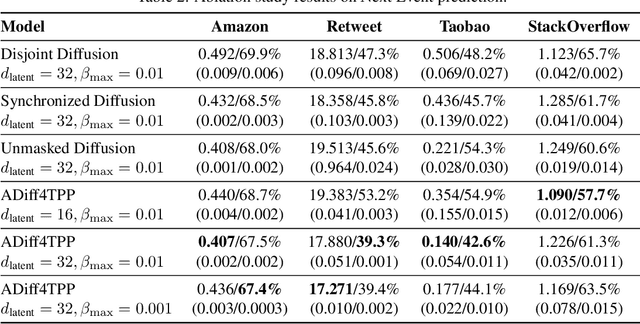
Abstract:This work introduces a novel approach to modeling temporal point processes using diffusion models with an asynchronous noise schedule. At each step of the diffusion process, the noise schedule injects noise of varying scales into different parts of the data. With a careful design of the noise schedules, earlier events are generated faster than later ones, thus providing stronger conditioning for forecasting the more distant future. We derive an objective to effectively train these models for a general family of noise schedules based on conditional flow matching. Our method models the joint distribution of the latent representations of events in a sequence and achieves state-of-the-art results in predicting both the next inter-event time and event type on benchmark datasets. Additionally, it flexibly accommodates varying lengths of observation and prediction windows in different forecasting settings by adjusting the starting and ending points of the generation process. Finally, our method shows superior performance in long-horizon prediction tasks, outperforming existing baseline methods.
The Power of One: A Single Example is All it Takes for Segmentation in VLMs
Mar 13, 2025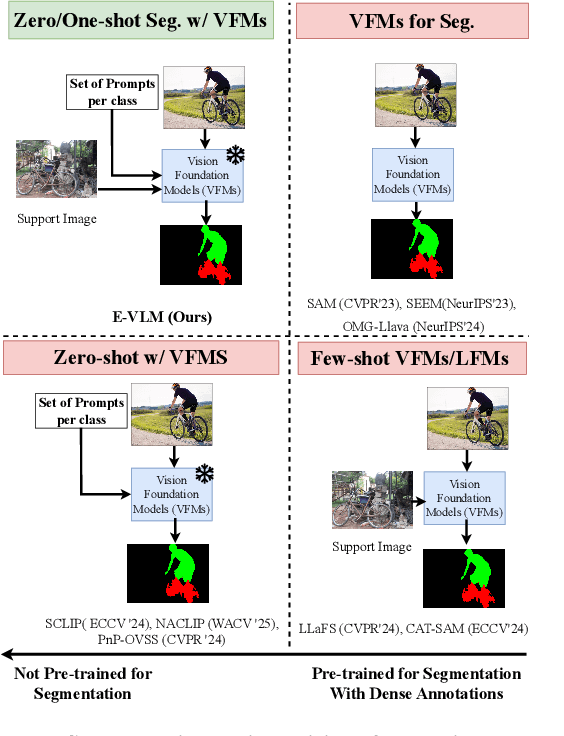
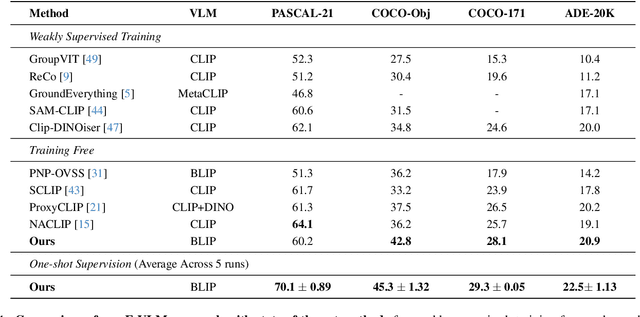
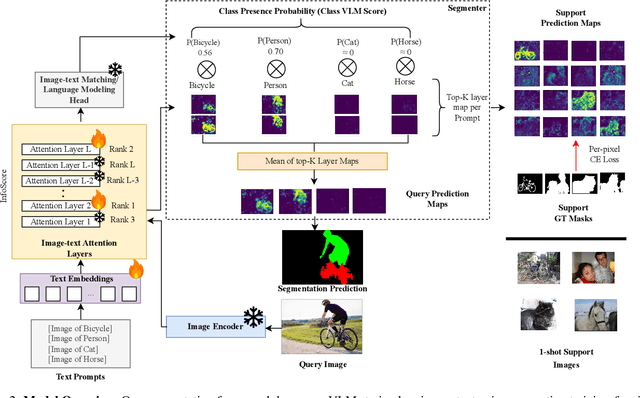
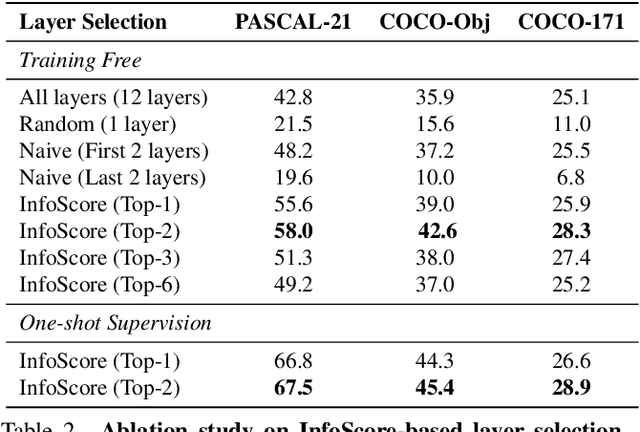
Abstract:Large-scale vision-language models (VLMs), trained on extensive datasets of image-text pairs, exhibit strong multimodal understanding capabilities by implicitly learning associations between textual descriptions and image regions. This emergent ability enables zero-shot object detection and segmentation, using techniques that rely on text-image attention maps, without necessarily training on abundant labeled segmentation datasets. However, performance of such methods depends heavily on prompt engineering and manually selected layers or head choices for the attention layers. In this work, we demonstrate that, rather than relying solely on textual prompts, providing a single visual example for each category and fine-tuning the text-to-image attention layers and embeddings significantly improves the performance. Additionally, we propose learning an ensemble through few-shot fine-tuning across multiple layers and/or prompts. An entropy-based ranking and selection mechanism for text-to-image attention layers is proposed to identify the top-performing layers without the need for segmentation labels. This eliminates the need for hyper-parameter selection of text-to-image attention layers, providing a more flexible and scalable solution for open-vocabulary segmentation. We show that this approach yields strong zero-shot performance, further enhanced through fine-tuning with a single visual example. Moreover, we demonstrate that our method and findings are general and can be applied across various vision-language models (VLMs).
BiasConnect: Investigating Bias Interactions in Text-to-Image Models
Mar 12, 2025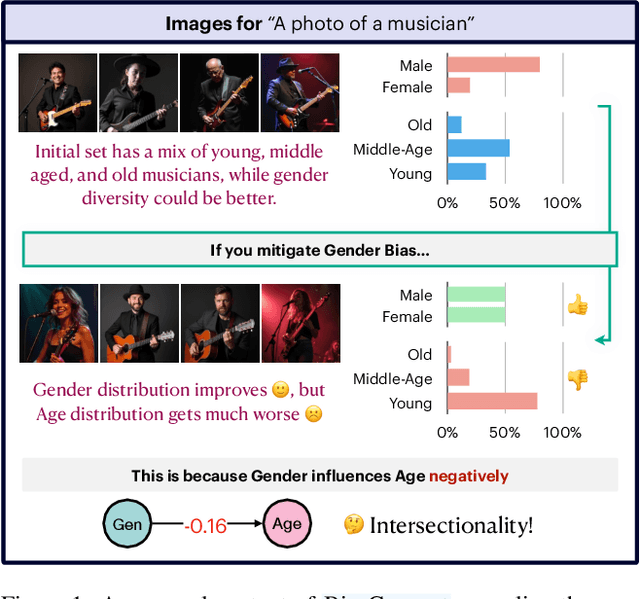
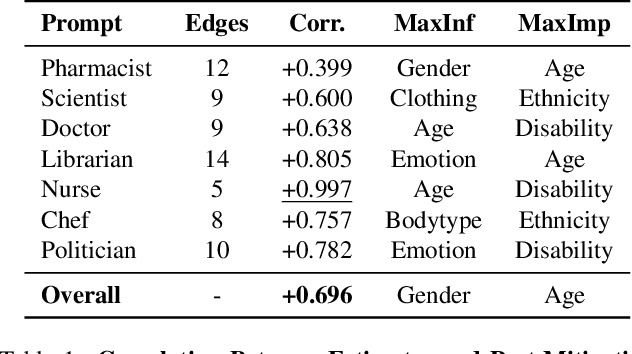
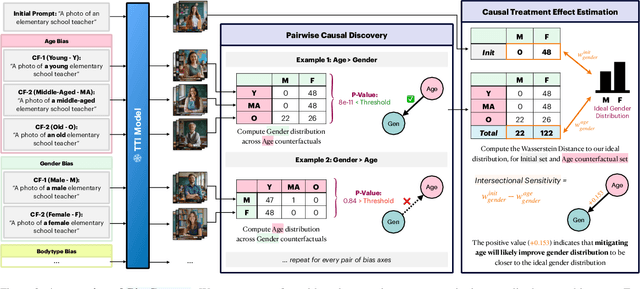
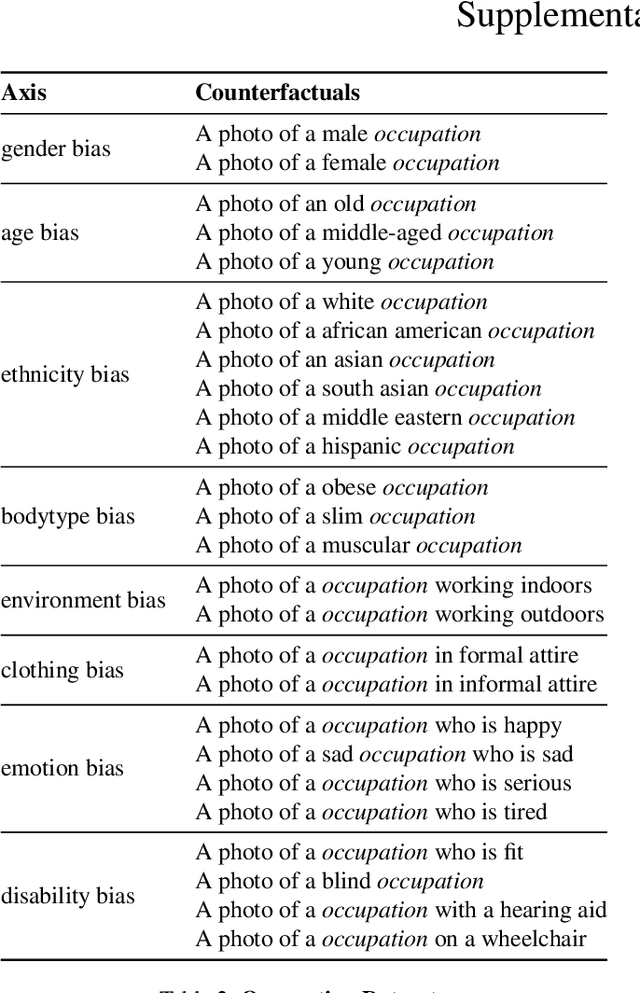
Abstract:The biases exhibited by Text-to-Image (TTI) models are often treated as if they are independent, but in reality, they may be deeply interrelated. Addressing bias along one dimension, such as ethnicity or age, can inadvertently influence another dimension, like gender, either mitigating or exacerbating existing disparities. Understanding these interdependencies is crucial for designing fairer generative models, yet measuring such effects quantitatively remains a challenge. In this paper, we aim to address these questions by introducing BiasConnect, a novel tool designed to analyze and quantify bias interactions in TTI models. Our approach leverages a counterfactual-based framework to generate pairwise causal graphs that reveals the underlying structure of bias interactions for the given text prompt. Additionally, our method provides empirical estimates that indicate how other bias dimensions shift toward or away from an ideal distribution when a given bias is modified. Our estimates have a strong correlation (+0.69) with the interdependency observations post bias mitigation. We demonstrate the utility of BiasConnect for selecting optimal bias mitigation axes, comparing different TTI models on the dependencies they learn, and understanding the amplification of intersectional societal biases in TTI models.
Leveraging Online Olympiad-Level Math Problems for LLMs Training and Contamination-Resistant Evaluation
Jan 24, 2025Abstract:Advances in Large Language Models (LLMs) have sparked interest in their ability to solve Olympiad-level math problems. However, the training and evaluation of these models are constrained by the limited size and quality of available datasets, as creating large-scale data for such advanced problems requires extensive effort from human experts. In addition, current benchmarks are prone to contamination, leading to unreliable evaluations. In this paper, we present an automated pipeline that leverages the rich resources of the Art of Problem Solving (AoPS) forum, which predominantly features Olympiad-level problems and community-driven solutions. Using open-source LLMs, we develop a method to extract question-answer pairs from the forum, resulting in AoPS-Instruct, a dataset of more than 600,000 high-quality QA pairs. Our experiments demonstrate that fine-tuning LLMs on AoPS-Instruct improves their reasoning abilities across various benchmarks. Moreover, we build an automatic pipeline that introduces LiveAoPSBench, an evolving evaluation set with timestamps, derived from the latest forum data, providing a contamination-resistant benchmark for assessing LLM performance. Notably, we observe a significant decline in LLM performance over time, suggesting their success on older examples may stem from pre-training exposure rather than true reasoning ability. Our work presents a scalable approach to creating and maintaining large-scale, high-quality datasets for advanced math reasoning, offering valuable insights into the capabilities and limitations of LLMs in this domain. Our benchmark and code is available at https://github.com/DSL-Lab/aops
MMFactory: A Universal Solution Search Engine for Vision-Language Tasks
Dec 24, 2024Abstract:With advances in foundational and vision-language models, and effective fine-tuning techniques, a large number of both general and special-purpose models have been developed for a variety of visual tasks. Despite the flexibility and accessibility of these models, no single model is able to handle all tasks and/or applications that may be envisioned by potential users. Recent approaches, such as visual programming and multimodal LLMs with integrated tools aim to tackle complex visual tasks, by way of program synthesis. However, such approaches overlook user constraints (e.g., performance / computational needs), produce test-time sample-specific solutions that are difficult to deploy, and, sometimes, require low-level instructions that maybe beyond the abilities of a naive user. To address these limitations, we introduce MMFactory, a universal framework that includes model and metrics routing components, acting like a solution search engine across various available models. Based on a task description and few sample input-output pairs and (optionally) resource and/or performance constraints, MMFactory can suggest a diverse pool of programmatic solutions by instantiating and combining visio-lingual tools from its model repository. In addition to synthesizing these solutions, MMFactory also proposes metrics and benchmarks performance / resource characteristics, allowing users to pick a solution that meets their unique design constraints. From the technical perspective, we also introduced a committee-based solution proposer that leverages multi-agent LLM conversation to generate executable, diverse, universal, and robust solutions for the user. Experimental results show that MMFactory outperforms existing methods by delivering state-of-the-art solutions tailored to user problem specifications. Project page is available at https://davidhalladay.github.io/mmfactory_demo.
What Has Been Overlooked in Contrastive Source-Free Domain Adaptation: Leveraging Source-Informed Latent Augmentation within Neighborhood Context
Dec 18, 2024Abstract:Source-free domain adaptation (SFDA) involves adapting a model originally trained using a labeled dataset ({\em source domain}) to perform effectively on an unlabeled dataset ({\em target domain}) without relying on any source data during adaptation. This adaptation is especially crucial when significant disparities in data distributions exist between the two domains and when there are privacy concerns regarding the source model's training data. The absence of access to source data during adaptation makes it challenging to analytically estimate the domain gap. To tackle this issue, various techniques have been proposed, such as unsupervised clustering, contrastive learning, and continual learning. In this paper, we first conduct an extensive theoretical analysis of SFDA based on contrastive learning, primarily because it has demonstrated superior performance compared to other techniques. Motivated by the obtained insights, we then introduce a straightforward yet highly effective latent augmentation method tailored for contrastive SFDA. This augmentation method leverages the dispersion of latent features within the neighborhood of the query sample, guided by the source pre-trained model, to enhance the informativeness of positive keys. Our approach, based on a single InfoNCE-based contrastive loss, outperforms state-of-the-art SFDA methods on widely recognized benchmark datasets.
 Add to Chrome
Add to Chrome Add to Firefox
Add to Firefox Add to Edge
Add to Edge